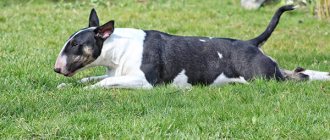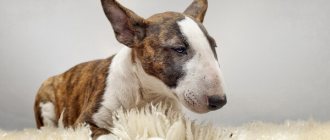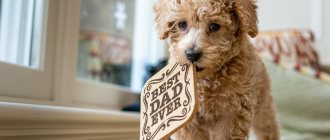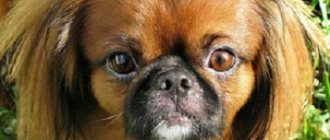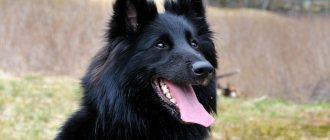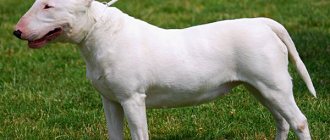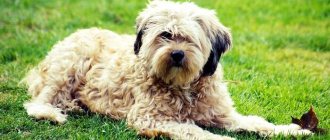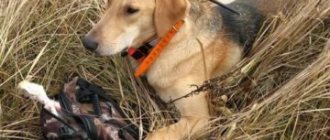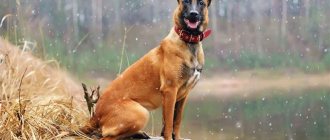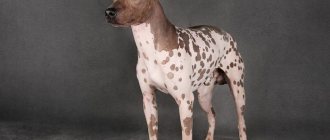Brief history of origin
Bull Terriers were bred in the 19th century in England. In those days, fights between dogs, in which bulldogs actively participated, were popular. But the spectators were not satisfied with the entertainment; they wanted more emotions from such events. Thus began the search for more resilient dogs with absolute fighting qualities.
The breed was created by crossing a bulldog and a white English terrier. It combines such qualities as dexterity, strength, a minimum threshold of pain sensitivity, resilience and strength of character. But with all these advantages, the bull terrier is short in stature.
Briefly about character and temperament
The Bull Terrier can be called an active, agile and very sociable dog. He is able to withstand significant loads, is self-sufficient and independent.
With proper upbringing, this is a wonderful companion, guard and everyone's friend..
However, if not properly trained, a dog can be aggressive, unpredictable and even socially dangerous. After all, the breed was bred as a fighting breed and all the qualities of a fighter were preserved in it.
This means that a lot of attention should be paid to education and training.
Description of the breed
The Bull Terrier is a strong, hardy, brave animal with a complex character and a muscular body.
These dogs are called gladiators of the canine tribe.
The description of the Bull Terrier breed contains the main features of its relatives - the strong grip of a bulldog and the agility of a terrier. In general, dogs are balanced and obedient, but sometimes they show stubbornness. When handled correctly, dogs are friendly with people.
The Bull Terrier can be trained to discipline. But calm, strict and persistent training is needed.
Breed standard: ideal body shape with a dense build. Anatomical deviations are almost never found in dogs.
Video
* We invite you to watch a video about the Bull Terrier . In fact, in front of you is a playlist in which you can select and watch any of 20 videos about a given dog breed by simply clicking on the button in the upper right corner of the window. In addition, the material contains quite a lot of photos. By looking at them you can find out what a Bull Terrier looks like.
In this article:
|
Kinds
Bull Terriers are characterized by three types:
- The Bulldog is strong, broad-chested with an impressive skeleton. The dog moves with swaying movements.
- The terrier is graceful, with a narrow chest and a long neck. Individuals with “square” shapes are rarely found. The dog's character is characterized by agility and quick temper.
- The Dalmatian has high legs and a long loin.
There is also a variety of height at the withers - standard individuals and miniature ones. Among the minis, the bulldog type is less common.
Types of pets
There are 4 types of the Bull Terrier breed that are allowed by the standards.
Bulldog
Distinctive features are compactness, massiveness, powerful bones, strong neck and wide chest. Such dogs are stockier and stronger, have elastic hips and a powerful body.
This type is quite rude, disproportionate and energetic, and also has a number of disadvantages:
- Short legs.
- Squatness.
- Short neck.
- Raised shoulders.
Terrier
The terrier type is distinguished by precision of lines, compactness and proportionality of the body . Typically, dogs of this type have lighter bones, a short back, straight and rather high limbs.
The disadvantages include:
- Lack of strength and energy.
- The frame is too light for this breed.
- Narrow chest.
- Excessive ease of movement.
Dalmatian
This type is distinguished by a neat and proportional exterior, a long neck and graceful limbs. The head of such pets is very long, but neat, the sides are flat, the muzzle is elongated and the tail is long.
Some representatives resemble a hound, which in no way corresponds to the standards of the bull terrier breed.
Intermediate
Intermediate type dogs took on the qualities of the other three . The head of such pets is proportional and has a slightly elongated shape. The neck is long and strong, the shoulder blades are set correctly, the paws are straight, the chest is wide. The tail is horizontal and low set.
This type of dog is less rough than the bulldog type, but stronger than terriers . At the same time, such a dog is quite compact, well built, but does not have grace.
Characteristics
Bull Terriers are characterized by:
- Shedding. Despite the fact that the breed is considered smooth-haired, dogs change their coat twice a year, in autumn and spring.
- Security ability. These dogs will always protect their family and owner.
- Guard qualities. The dog will warn you of danger in time and protect your property.
- Loyalty and patience with children. Bull Terriers are excellent nannies.
- Incompatibility with other animals in the same territory.
- High need for regular walks and physical activity.
- Dogs are trainable - they easily learn to obey their owner’s commands and do not require careful grooming.
- Keeping this breed in an apartment is possible without compromising its condition and health.
- These dogs love to overcome obstacles.
Disadvantages of Bull Terriers: what you need to know in advance
Breeders warn: everything in the world must be in balance. The Bull Terrier will delight, touch and delight you. And just as often he will infuriate you, sometimes driving you to despair.
Deliberate disobedience
Even a well-bred bull terrier can experience bouts of “selective deafness” that will drive you crazy. Having learned and perfected a command, the dog simply stops following it.
Boule will test your strength throughout your life, trying to expand the boundaries of what is permitted. Over time, you will get used to it, and you will be reminded who is boss in passing. But you can't give in. If you forbid your dog to beg, and another day, after thinking, you throw a piece from the table - this is a failure. Be consistent, decide in advance and clearly what is possible and what is not.
Am I not the boss of the house?
Can't stand loneliness
Getting a bull terrier is about the same as bringing a three-year-old child into the house. You don’t leave your children alone for 8-12 hours, do you? And if you leave it, then don’t be surprised at the destruction in the apartment. A young bull terrier, out of boredom and anxiety, gnaws on everything it comes across. It’s especially good if the item has the scent of a departed owner – that’s why the shoes are the first to suffer.
Powerful jaws are capable of crushing a wooden chair into small splinters, and natural stubbornness does not allow the bull to stop until all the linoleum is torn off the floor. If the bull terrier does not agree to stay in a locked room, he will break down the door with his cast iron head. Most often - successfully.
It is worth thinking about your schedule in advance if you are taking a bull terrier puppy into your home. And abandon this idea if you are not ready to devote enough time to the dog.
A puppy in the house is not only a great joy, but also a great responsibility.
Unhealthy public attention
Wherever you go with your bull terrier, there will be those who have read the yellow press at one time. Even at a dog park, owners may ask you to put your “killer” on a leash, even if the dog is only 6-7 months old... The situation is aggravated by the fact that most people do not distinguish between 4 different breeds of dogs:
- The English Standard Bull Terrier is what we are talking about in this article;
- English Staffordshire Bull Terrier;
- American Pit Bull Terrier, pit bull;
- American Staffordshire Terrier, Amstaff.
You will hear phrases like “Pona, “Hold him, don’t you see, my toy/sneeze/Yorkie is throwing himself!” You will need a lot of patience and a lot of self-control. And if you don’t have these qualities, then you shouldn’t have a bull terrier.
Lifehack for bull terrier owners: funny pet costumes will help calm down Grandma Galya from the next apartment and mothers from the playground
Look, I'm white and fluffy, a harmless bull
It's hard to be afraid of someone in an elf unicorn costume
Your dog will always be under close attention, so his reputation must be crystal clear. God forbid you forget your poop bag at home or run towards a flock of pigeons. What is forgivable for a cute beagle or fluffy Samoyed is not forgivable for a bull terrier.
Bull Terrier Character
Bull Terriers are unconditionally devoted to their owner and family and get along with any person, be it an adult or a child. A dog can find a common language with pets, but only if it grew up with them. He is aggressive towards other dogs, especially of the same sex. The main trait in the dog’s character is calmness.
Discipline and unquestioning obedience from a dog are achieved through education.
Good to know: The most dangerous dog breeds in the world
Training and physical characteristics of the breed
The stubborn little puppy does not understand the command the first time, he will understand the second, third, fifth. But, due to his stubbornness, he will remember her for a long time. Treats help to cope with stubbornness, and bull terriers have an excellent appetite.
A standard bull terrier, depending on its weight, can eat up to a kilogram of food per day; a miniature bull terrier eats a little less.
How a bull terrier eats food is not a sight for the faint of heart. From the photo of a bull terrier you can see how impressive their jaws are, but they are not a threat to humans.
There are dogs that serve in the Ministry of Emergency Situations and actually participate in combat missions to rescue people from the rubble. In such service, the bull terrier is helped by very strong muscles; its development is an obligatory element of the dog’s upbringing and an ordinary walk is not enough.
Car tires are often used in CrossFit as additional weights, but when you combine a tire with a leash, it becomes an ideal exercise machine for a bull terrier.
A bull terrier can carry a 15-kilogram tire for at least an hour. If you add a second one, the load will become heavier than the athlete himself, but the dog’s tenacity knows no bounds. Don’t think that the dog doesn’t like it, bull terriers are happy to pull sleds, or individual skiers as part of the skijoring championship.
Appearance
The Bull Terrier has a strong, muscular build. The dog's head is long, and from the side it looks like an egg. On top it is almost flat, arched from the top of the head to the nose. The nostrils are pronounced and open. The dog has strong teeth with a regular scissor bite.
Animals have a special eye shape, similar to a triangle, with an oblique fit. The color is dark brown.
These dogs have small, thin, erect ears located next to each other.
The body is round in shape with protruding ribs. A dog's chest is located much lower than its stomach.
The weight of one individual is from 18 to 30 kg. Height – 35-45 cm. The exception is miniature dogs, their height at the withers does not exceed 35.5 cm.
Common bull terrier colors: black and white, brown, red, brindle, black.
Development, growth features
By one month, puppies begin to eat and play actively. Normal indicators: height - 15-17 cm at the withers, weight 3.5-4 kg. A shortfall in indicators indicates deviations. In this situation, veterinary supervision is required.
At 2 months, the baby is transferred to independent 6 meals a day. They grow up to 20-22 cm at the withers and already weigh 4.5-5 kg.
At 3 months, it is recommended to begin the process of socialization of puppies : they are accustomed to the place, to the first commands. This is the best age to move to a new owner. The babies reach 26-28 cm at the withers and weigh 8-8.5 kg.
If the owner has the opportunity to observe the development of the future pet, he will be able to assess how well it complies with the standards.
Upbringing
You need to start raising a bull terrier puppy from the moment it arrives in its new home. Future owners need to prepare in advance and learn some techniques.
It is necessary to clearly explain to the dog where the toilet and food are, and that you should not chew things.
There are certain rules of communication:
- At first, it is advisable to devote more time to the dog, play and talk with it. This will strengthen trust and mutual understanding between the dog and the owner.
- Analyze and try to understand the reasons for the actions and behavior of the animal.
- Show calm and patience when training your dog.
- Never lose your temper and punish your dog unnecessarily.
Conditions of detention
Bull Terriers feel great in a city apartment. They are not intended for life on the street and feel comfortable in close proximity to humans.
The owner should take into account that bull terriers are very active. Therefore, they need to be given the opportunity to throw out pent-up energy during long walks. In this case, preference should be given not to walking routes, but to places where the dog can run freely - parks, special stadiums, large dog parks.
Training
It’s worth signing up for courses with an experienced dog handler and being prepared that all responsibility and results will depend only on the efforts made.
It is not necessary to train a bull terrier according to the general course. All you need to do is learn the commands:
- "to me";
- "near";
- "ugh";
- "place";
- "sit";
- "lie";
- "fetch";
- "give".
Rules:
- Systematic training should begin at 6-8 months.
- The sequence from simple to complex is important. When learning one command, you need to achieve good execution of it and reward the puppy for this with a treat. Do not move on to another lesson if there is no good result from the previous one.
- An excellent time to train is in the morning before meals or 1.5-2 hours after meals.
- It is advisable to alternate training with rest.
- Commands must be pronounced clearly, confidently, without changing or adding unnecessary words.
Care and maintenance of a bull terrier
Baths are not recommended for healthy animals.
- The dog's short, coarse fur is combed with a soft brush.
- The dog's eyes and ears are wiped with a damp cloth every day.
- The claws are cut with special scissors (claw clippers).
- To clean teeth and prevent oral diseases, the animal is given bones and toys. If desired, buy toothpaste and a brush at the pet store, and clean the dog’s mouth once a week.
- For a puppy, buy a soft collar, and for an adult dog, a harness.
How to choose?
Bull Terriers are a popular and widespread breed of dog, so finding a kennel that specializes in breeding them is not difficult. You should not buy a puppy from your own hands - in this case there is no guarantee of its health and purebred.
In a healthy, standard puppy:
- 6 teeth each on the upper and lower jaws;
- large egg-shaped head;
- scissor bite;
- small triangular eyes;
- smooth and shiny coat;
- clean eyes and skin.
Rash, scratching, dandruff, bloated belly, increased lacrimation, unpleasant odor from the ears, nasal discharge indicate the presence of any pathologies in the puppy.
You should test your puppy's hearing by clapping your hands or using a squeaky toy and assessing his reaction.
Nutrition
The Bull Terrier needs a high protein content, high-calorie, easily digestible food, vitamins and microelements.
Dogs are fed in two ways: prepared (dry, canned) or natural food.
- For the first weeks, puppies of 2-3 months are fed the same way as the breeder did. Then the diet consists of 50% meat products and offal. Some of the dog's food is given raw, cut into pieces. Your dog's diet should also include:
- fermented milk products (kefir, yogurt, cottage cheese, cheese, sour cream, cream);
- fresh, grated vegetables (pumpkin, carrots, cauliflower, zucchini);
- rye bread and crackers, as well as a variety of cereals;
- eggs (it is not recommended to give your dog more than three times a week).
At this stage, vitamin and mineral complexes are added.
- The diet of an adult bull terrier differs from the diet of a three-month-old puppy only in the amount of food. The meat is cut into pieces, but the vegetables are given whole.
Dogs are prone to obesity, so they should not be fed baked goods made from white flour, sweet fruits, fatty foods and prepared meat delicacies (sausage, smoked sausages). It is also not recommended to give dogs grapes, raisins, chocolate, rabbit and chicken bones, fish and legumes.
What diseases are bull terriers susceptible to?
The average life expectancy of bull terriers is 10-12 years. They have a strong constitution and with good care, such a dog visits a veterinarian only for preventive vaccinations. However, there are points that you need to pay attention to.
Polycystic kidney disease
There is a dominant gene circulating in the breed that causes an incurable congenital kidney disease. With polycystic disease, multiple blisters filled with fluid form in the kidneys, and less and less working tissue remains. Because of this, the young bull terrier dies from acute renal failure. The average life expectancy of a dog with polycystic kidney disease is 3-6 years. There is no treatment, although a special diet and medications can help prolong the pet's life.
Cysts can be detected on ultrasound when the puppy is six months old and later. There is reliable genetic testing that should be performed on all Bull Terriers being bred. You can also have the puppy tested before purchasing if its parents have not had this test done.
Bull Terrier puppy
Lethal acrodermatitis of bull terriers
This disease only appears if the puppy receives the defective gene from both parents. Therefore, the disease cannot be eradicated: most dogs are hidden carriers of acrodermatitis, and only a few puppies die from it.
Lethal acrodermatitis is named so for a reason. The disease cannot be treated; affected dogs do not live beyond 2 years of age; most die before the age of one year. A sick puppy does not gain weight, its paws become deformed, and various lesions develop on the skin. Acrodermatitis is accompanied by immunodeficiency, so the dog may die from pneumonia or an intestinal infection.
There is a genetic test that can be used to determine whether a dog is a carrier of this disease.
Deafness
Bull Terriers are one of the dog breeds with a high risk of congenital deafness. In those days when only pure white bulls were bred, every tenth dog was deaf. Now the risk of having a deaf puppy is much lower, but unfortunately no one is immune from this. Even two perfectly hearing parents can give birth to a deaf puppy. This is due to the action of the dominant white color gene W.
It is a big mistake to think that only a snow-white bull terrier can be deaf. Unfortunately, patches of color or even full color does not guarantee protection against hearing loss.
You can check your puppy's hearing using the Bayer test. The only problem is that such research is not performed in all veterinary clinics; special equipment is needed. The Bayer test detects deafness in one or both ears. A good breeder will definitely test the litter at the age of 40-45 days, receiving a certified certificate.
Newborn bull terrier
A completely deaf bull terrier is a tragedy. Keeping such a dog is really not easy. You may not notice deafness in one ear without special tests. But this is a reason to exclude your pet from breeding!
Allergy
Like their Bulldog ancestors, Bull Terriers are extremely prone to skin problems. They often have food allergies. And a much more dangerous problem is atopic dermatitis, in which the skin reacts to environmental allergens.
Bullies are sensitive to insect bites - not only fleas, but also regular mosquitoes. An encounter with a wasp or a bee is also dangerous for them. It would be helpful for a bull terrier owner to read the article “What to do if your dog is bitten by a snake” (opens in a new tab) if there is even the slightest chance that your bull terrier will encounter a viper.
The owners wanted to euthanize this bull terrier due to severe atopic dermatitis.
Health and breed diseases
Most bull terriers are in excellent health. But if serious problems arise, it is advisable to immediately contact a veterinarian to make a correct diagnosis and treat the dog.
Breed diseases:
- deafness (such animals are rejected);
- acrodermatitis - lack of zinc in the body. Newborn puppies appear with flat, everted limbs;
- renal failure. This disease can appear in a dog at any age, but timely treatment and diet will save the pet;
- heart diseases. Some individuals live fully, while others suffer from shortness of breath, seizures and decreased activity;
- entropion of the eyelid, allergies and joint dysplasia;
- dermatitis, manifested in the form of bald spots near the croup on the tail and on the bends of the elbows.
When properly maintained, Bull Terriers live an average of 12-15 years. However, do not forget about timely vaccinations, regular visits to the veterinarian, proper nutrition and physical activity.
Predisposition to disease
No specific genetic pathologies have been identified in representatives of the breed, but they are most often exposed to certain diseases. This:
- dislocation of kneecaps and elbows;
- turning of the eyelids;
- joint dysplasia;
- aortic stenosis;
- epilepsy;
- deafness.
An adult pet is at high risk of developing cancer. Puppies can suffer from a rare disease - lethal acrodermatitis. These animals have very thin skin, so in summer they need to be protected from sunburn and mosquito bites, which can cause hives and severe itching.
Advantages and disadvantages
Pros:
- Athletic build.
- Easy to learn basic commands and specialized skills.
- Good sense of smell and memory.
- Unpretentiousness to living conditions and food.
Minuses:
- Grudge.
- Stubbornness.
- Ability to dominate.
Rules for choosing puppies
If you need a purebred bull terrier, then it is advisable to choose one from a kennel. You may end up with a non-purebred puppy who will not be allowed to participate in exhibitions.
What rules should you follow when choosing a puppy:
- Before purchasing, it is recommended to read the relevant literature, visit dog shows and talk with bull terrier owners.
- Mucous membranes are allowed without erosion, the tail is without kinks, the paws are the same length, straight, the nose is wet, the eyes are without discharge.
- The puppy must be vaccinated according to age.
- Deafness is common in animals. Therefore, when choosing a dog, it is advisable to lightly flick your finger above its ear and evaluate the reaction.
Basic colors
According to breed standards, the color of the Bull Terrier should be white.
In this case, skin pigmentation does not matter. However, other colors are also acceptable, the owners of which can also participate in exhibitions and win prizes.
White
White is considered the most common and preferred color, with the standard allowing for spots of a different color on the face, head, neck or ears. Even in this case, the color will be considered white.
But, if there are spots on the body or legs, the color will be considered white with markings.
Ginger
Red is considered a color in which the dog is completely covered with red hair. In this case, the shade can be anything, from dark brown to light red.
However, a very light color is considered fawn and is undesirable, as it leads to a decrease in points at shows..
Black
A completely black color in a Bull Terrier is extremely rare; in most cases, such dogs have white spots on their paws, face or neck, but in this case, the color will be considered two-tone.
Two-color (bicolor)
The bi-colored Bull Terrier may have areas of white, and these may be located on the paws, tail, muzzle or chest.
The main condition is that white spots should not occupy more than 50% of the body surface.
Tricolor
This color may include:
- Black.
- Ginger.
- White.
- Brown.
According to the standard, a tricolor dog should have no more than 50% white . Other colors must be clearly distinguishable and can be of any proportion.
brindle
As a rule, in such pets the red color acts as the main color and is complemented by black stripes. At the same time, the standards allow black color as the main color with red stripes.
White markings are also allowed on the entire body except the muzzle . If white spots are present on the face, then the color is considered brindle-white.
Grey
This color is quite rare and, as a rule, is a sign of a non-purebred dog.
Animals of this color are usually not allowed to exhibitions and do not participate in breeding work.
Brown
Brown color is considered one of the variants of red and can have any shades except fawn.
Fawn coloring is considered undesirable and such dogs are not allowed for breeding..
Reviews
Pavel: “My girlfriend and I went to a dog show, and we really liked the bull terrier breed. Relatives began to dissuade us, saying that these were dangerous animals, angry and aggressive. But we still decided to get a puppy. Our happiness knows no bounds; he is the most responsive, loving dog I have ever met.”
Christina: “My husband and I wanted to buy a bull terrier puppy for a long time, but we were afraid of how the dog would treat children. Now we have a puppy at home named Lari (that’s what our sons named him). They are very friendly, and my husband and I are incredibly glad that the dog turned out to be a sincere, understanding and loving creature.”
Mikhail: “I have been breeding bull terriers for 10 years. These dogs are strong and love an active lifestyle. The character and behavior of animals largely depends on the owner’s attitude towards them. Dogs, like other living beings, love affection and care.”
The Bull Terrier is a fighting dog with intelligence and a strong character. Dogs are loyal and will never show aggression “just because.” By following the rules of communication with an animal, you can find a friend for life.
Is your pet dangerous?
The opinion that representatives of this breed are a priori dangerous and have innate anger, aggression and an unbalanced psyche is a myth.
Of course, these are powerful dogs that, in the heat of rage, can bite a cat without opening their jaws, but before drawing any conclusions, you should learn more about them.
Firstly, the aggressive attitude of representatives of this breed is never directed at people - this was closely monitored at all times and dogs that showed unmotivated anger towards humans were immediately excluded from breeding.
Secondly, even the aggression towards other animals, including cats, inherent in Bullers, can be overcome with proper education and socialization.
The degree of danger of a dog, as well as the adequacy of its behavior, depend only on the owner and how responsibly he approached the issue of raising the pet.
